The Evolving of the Distinction between Transcendence and Immanence as triggered by Intra- and Interreligious Encounter

The project is connected to a new edition, (English) translation and extensive commentary of the “Records of the Western Regions” (Datang xiyu ji), a 7th century travelogue by the Chinese monk Xuanzang (600?-664). The commentary will not only give copious notes on philological and thematic issues and problems of the text but will also provide a hermeneutic and contextual discussion of its being situated “between cultures and religions” insofar as it was written as a “description” of India by a Chinese Buddhist familiar with Indian culture and religion for a Chinese audience, foremost for the second Tang emperor Taizong.
One of the fascinating aspects of Xuanzang, his biography, and his voluminous work is the fact that as a translator and philosopher he is highly focused on the philosophy and doctrines of the so-called Buddhist school of Idealism, Yogācāra or Vijñānavāda, and of the Abhidharmaśāstra-tradition of the Sarvāstivādin; yet, the work which had the greatest impact on East Asian culture, going far beyond China into Korea, Japan, and Vietnam, is Xuanzang’s travelogue and his biography which “describe” an idealized India as the Sacred Land of Buddhism – the notion of Sacred Land raising the question to what extent its description contains elements of transcendence. It is here where transcendence – in form of references to Buddhist narratives and teachings – and immanence – the description of the situation of society and culture and practiced Buddhism in India (and parts of Central Asia) – encountering each other in a context of a “between cultures” (India – China).
The project would like to explore this hitherto unstudied relation between immanent “description” – “pointing at” in the terminology of the description to the annual topic, and therefore already implying a possible discursive transcendence-immanence distinction – of Indian Buddhism and Xuanzang’s obvious focus on the question of transcendence in his other works and thereby contribute to the question of how and if contact of cultures and religions. I suggest that most aspects of the topic described in the description to the annual topic (e.g. here and now vs. there and then, religion as communication, self-reference, both individual as cultural) can be tested against the material and the sources used in the resrearch project.
Affiliated Persons


